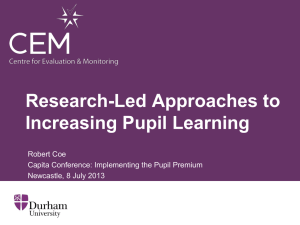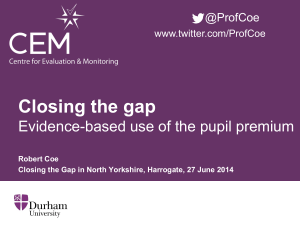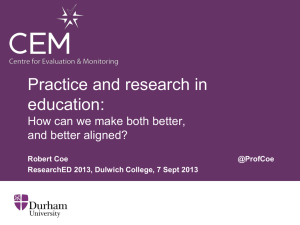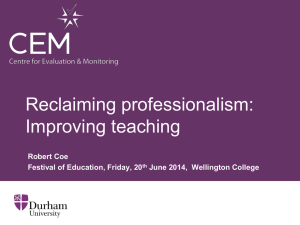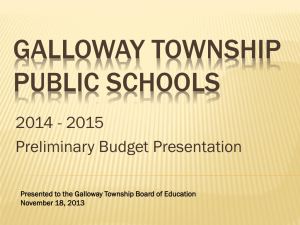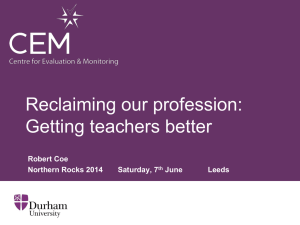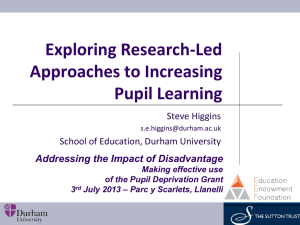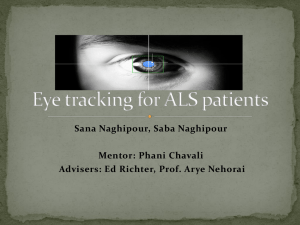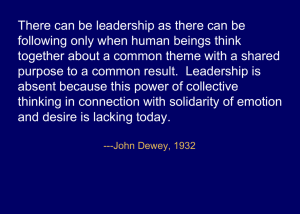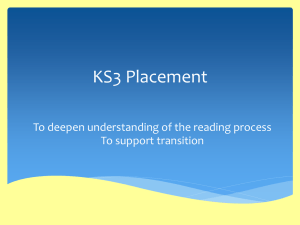Research-Led Approaches to Increasing Pupil Learning
advertisement
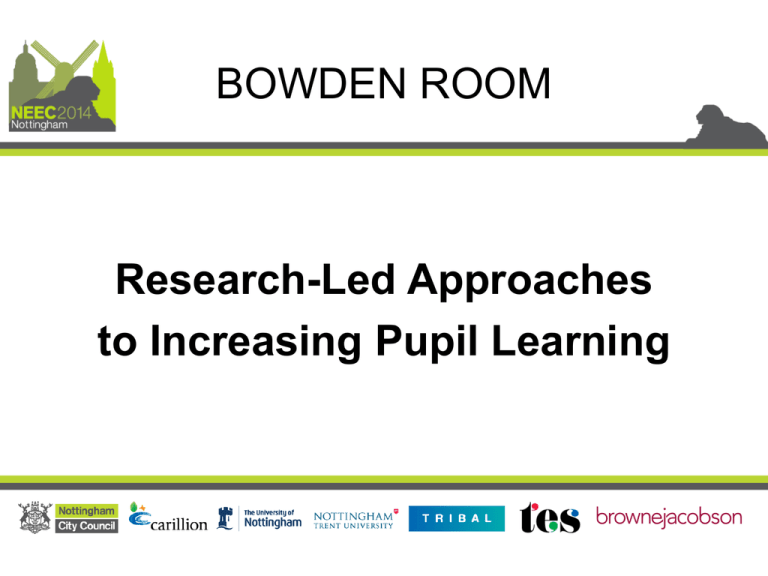
BOWDEN ROOM Research-Led Approaches to Increasing Pupil Learning Research-Led Approaches to Increasing Pupil Learning Professor Robert Coe Director of the Centre for Evaluation and Monitoring at Durham University Research-Led Approaches to Increasing Pupil Learning Robert Coe North of England Education Conference 2014 Nottingham, 15 January Outline How can we use school resources to get the biggest increases in learning? What can research tell us about the likely impact of different strategies? ∂ these strategies? How do we implement What else do we need do to make it likely that attainment will rise? Improving Education: A triumph of hope over experience http://www.cem.org/attachments/publications/ImprovingEducation2013.pdf 5 Evidence about the effectiveness of different strategies 6 Toolkit of Strategies to Improve Learning ∂ The Sutton Trust-EEF Teaching and Learning Toolkit http://www.educationendowmentfoundation.org.uk/toolkit/ Effect Size (months gain) Impact vs cost www.educationendowmentfoundation.org.uk/toolkit Most promising for raising attainment 8 May be worth it Feedback Meta-cognitive Peer tutoring Homework (Secondary) Collaborative Early Years 1-1 tuition ∂ Behaviour Small gp Phonics Parental tuition involvement ICT Social Individualised Summer schools learning Mentoring Homework (Primary) Performance Aspirations 0 pay £0 Ability grouping Cost per pupil Smaller classes After school Teaching assistants £1000 Small effects / high cost Key messages Some things that are popular or widely thought to be effective are probably not worth doing – Ability grouping (setting); After-school clubs; ∂ Teaching assistants; Smaller classes; Performance pay; Raising aspirations Some things look ‘promising’ – Effective feedback; Meta-cognitive and self regulation strategies; Peer tutoring/peer‐assisted learning strategies; Homework Clear, simple advice: Choose from the top left Go back to school and do it ∂ For every complex problem there is an answer that is clear, simple, and wrong H.L. Mencken 10 Why not? We have been doing some of these things for a long time, but have generally not seen improvement Research evidence is problematic – Sometimes the existing evidence is thin ∂ reflect real life – Research studies may not – Context and ‘support factors’ may matter Implementation is problematic – We may think we are doing it, but are we doing it right? – We do not know how to get large groups of teachers and schools to implement these interventions in ways that are faithful, effective and sustainable 11 So what should we do? 12 Four steps to improvement Think hard about learning Invest in good professional development Evaluate teaching ∂quality Evaluate impact of changes 1. Think hard about learning Effect Size (months gain) Impact vs cost www.educationendowmentfoundation.org.uk/toolkit Most promising for raising attainment 8 May be worth it Feedback Meta-cognitive Peer tutoring Homework (Secondary) Collaborative Early Years 1-1 tuition ∂ Behaviour Small gp Phonics Parental tuition involvement ICT Social Individualised Summer schools learning Mentoring Homework (Primary) Performance Aspirations 0 pay £0 Ability grouping Cost per pupil Smaller classes After school Teaching assistants £1000 Small effects / high cost Poor Proxies for Learning Students are busy: lots of work is done (especially written work) Students are engaged, interested, motivated Students are getting attention: feedback, explanations Classroom is ordered, calm, under control ∂ Curriculum has been ‘covered’ (ie presented to students in some form) (At least some) students have supplied correct answers, even if they – – – – Have not really understood them Could not reproduce them independently Will have forgotten it by next week (tomorrow?) Already knew how to do this anyway 16 A simple theory of learning Learning happens when people have to think hard ∂ Hard questions about your school How many minutes does an average pupil on an average day spend really thinking hard? Do you really want pupils to be ‘stuck’ in your ∂ lessons? If they knew the right answer but didn’t know why, how many pupils would care? 18 2. Invest in effective CPD How do we get students to learn hard things? Eg Place value Persuasive writing Music composition Balancing chemical equations • Explain what they should do • Demonstrate it • Get them to do it (with gradually reducing support) ∂ • Provide feedback • Get them to practise until it is secure • Assess their skill/ understanding How do we get teachers to learn hard things? Eg Using formative assessment Assertive discipline How to teach algebra • Explain what they should do ∂ What CPD helps learners? Intense: at least 15 contact hours, preferably 50 Sustained: over at least two terms Content focused: on teachers’ knowledge of subject content & how students learn it ∂ try it out & improve Active: opportunities to Supported: external feedback and networks to improve and sustain Evidence based: promotes strategies supported by robust evaluation evidence Evaluated: so we know the impact on learning 3. Evaluate teaching quality Every teacher needs to improve, not because they ∂ are not good enough, but because they can be even better. Dylan Wiliam Monitoring the quality of teaching Classroom observation – Much harder than you think! – Multiple observations/ers, trained and QA’d ∂ Progress in assessments – Quality of assessment matters Student ratings – Extremely valuable, if done properly 25 4. Evaluate impact of changes School ‘improvement’ often isn’t School would have improved anyway – Volunteers/enthusiasts improve: misattributed to intervention – Chance variation (esp. if start low) Poor outcome measures – Perceptions of those who worked hard at it – No robust assessment of pupil ∂ learning Poor evaluation designs – Weak evaluations more likely to show positive results – Improved intake mistaken for impact of intervention Selective reporting – Dredging for anything positive (within a study) – Only success is publicised (Coe, 2009, 2013) Key elements of good evaluation Clear, well defined, replicable intervention ∂ Good assessment of appropriate outcomes Well-matched comparison group Summary … 1. Think hard about learning 2. Invest in good CPD 3. Evaluate teaching quality ∂ 4. Evaluate impact of changes Robert.Coe@cem.dur.ac.uk www.cem.org @ProfCoe Research-Led Approaches to Increasing Pupil Learning
